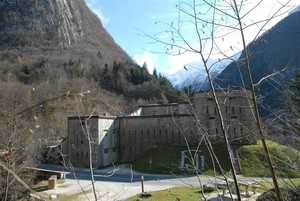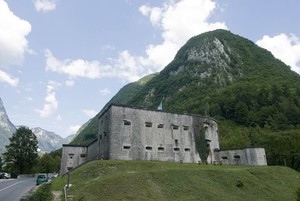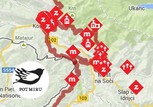Kluže Fortress
The external appearance and purpose of Kluže Fortress often changed through its history. It was built at the narrowest part of the Koritnica Valley to block the strategically important passage. The first wooden building was erected by the Venetians in the second half of the 15th century to defend the Venetian Republic against the Turks. At the beginning of the 16th century, when it came under Habsburg rule, the first stone fortress was built and was renovated several times thereafter. In 1797, in the Napoleonic period, the French army burnt down and destroyed the medieval fortress. The most recent, present fortress was built under the Austro-Hungarian Empire from 1881 to 1882. It was called Flitscher Klause/Bovške Kluže. The fortress was designed to control the passage from the Bovec Basin through the Predel Pass to the interior of the Empire. The Isonzo Front line was in the immediate vicinity. The steep walls of Mt Rombon sheltered the fortress from direct Italian shelling The headquarters and support echelon were located there; it was also used as a first-aid station. A number of defensive and supply facilities were added, such as a small power plant, water pump, observation posts with searchlights, etc.
In the period before the Second World War, the fortress was devastated. Most of its steel was stripped off, as there was a shortage of raw material in Italy. In the 1945-1947 period, i.e. under the Allied Military Government, the defensive wall and its entrance portal were demolished to make way for road widening and bridge reconstruction. Today, Kluže Fortes houses a permanent museum collection and occasional exhibitions. In summer, it becomes an important cultural centre offering numerous events.






